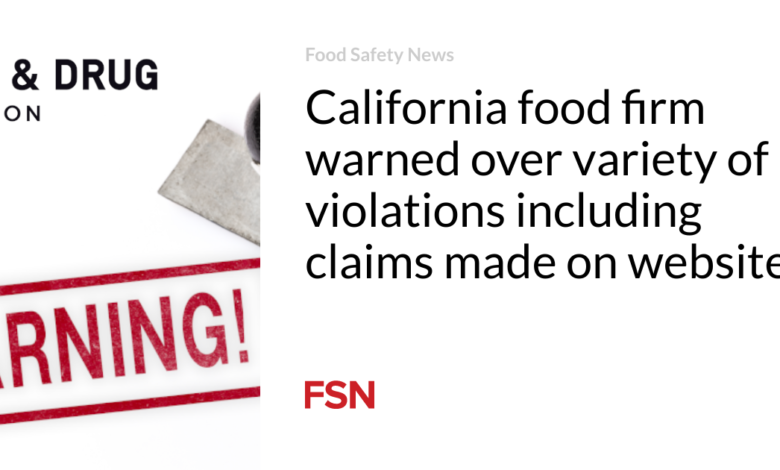California food firm warned over variety of violations including claims made on website

As part of its enforcement activities, the Food and Drug Administration sends warning letters to entities under its jurisdiction. Some letters are not posted for public view until weeks or months after they are sent. Business owners have 15 days to respond to FDA warning letters. Warning letters often are not issued until a company has been given months to years to correct problems.
Living Tree Community Foods Inc.
Berkeley, CA
A food firm in California is on notice from the FDA for violations of various federal regulations, including: Hazard Analysis and Risk-Based Preventive Controls regulation, Current Good Manufacturing Practice, Unapproved New Drugs and Misbranded Drugs, and Misbranded Foods.
In a March 4 warning letter, the FDA described a Feb. 13 through March 17, 2023, inspection of Living Tree Community Foods’ manufacturing facility located in Berkeley, CA. The FDA also reviewed the firm’s labels and website, www.livingtreecommunityfoods.com, on Oct. 11, 2023.
The FDA’s inspection revealed that the firm was not in compliance with federal regulations and resulted in the issuance of an FDA Form 483.
Some of the significant violations are as follows
Hazard Analysis and Risk-Based Preventive Controls:
1. The firm’s hazard analysis did not appropriately evaluate all known or reasonably foreseeable hazards to determine whether there are hazards requiring a preventive control for their RTE nut and seed butters, as required.
Specifically, the firm manufactures 25 different RTE nut & seed butters using a variety of tree nuts (almonds, Brazil nuts, pecans, walnuts, pine nuts, cashews, hazelnuts, pistachios, macadamia, and coconuts) and seeds (sesame seeds, pumpkin seeds, sunflower seeds, and hemp seeds). Their hazard analysis for “RTE Living Tree Community Foods alive & organic Walnut Butter, organic Milk of Paradise Cashew & Macadamia Butter, and alive & organic Sesame Tahini,” included in their “Food Safety Plan For Nut and Seed Butters, Muesli, Bars, and oils Version 2” dated March 21, 2020, did not identify biological, chemical, and physical hazards associated with these products and with tree nuts/seeds as significant hazards which require a preventive control at receiving, storage, slicing nuts and seeds, holding in bin, mixing (redacted by the FDA) /cooling, and/or packaging steps.
A. The firm’s hazard analysis considered “Presence of pathogenic bacteria” associated with their seeds and tree nut ingredients at their receiving step, but they determined that the hazard was not significant. However, vegetative pathogens such as Salmonella have been associated with these tree nuts and seeds food products. Therefore, the pathogen of Salmonella is a known or reasonably foreseeable hazard. Further, a knowledgeable person manufacturing/processing food in their circumstances would identify pathogens as a hazard requiring a preventive control in these ingredients. The hazard may be controlled during their processing or at their supplier. Their process does not apply a process preventative control such as a lethal treatment to any of their incoming raw materials and ingredients used in production of their RTE nut and seed butters. The firm’s manager stated that all tree nuts and seeds used to manufacture their RTE nut and seed butter products are received raw, but only their almonds and cashews receive a treatment at the supplier to reduce pathogens. The firm told FDA investigators that their firm did not identify pathogens (pathogenic E. coli and/or Salmonella) as a significant hazard requiring a preventive control for tree nuts and seeds because these hazards can be controlled by their existing prerequisite programs as listed in their hazard analysis. These prerequisite programs include “Approved Supplier Program,” “Good Manufacturing Practices” and “Receiving and Storage Practices.” However, these written programs did not have procedures in place to verify that the supplier is controlling pathogens that may be present in raw materials to mitigate the hazard.
The firm maintains an “Approved Supplier Program” whereby they request the supplier to complete an “Approved Supplier Questionnaire” (redacted by FDA) and (redacted by FDA), thereafter. Their 2022 Supplier List showed they have (redacted by FDA) approved suppliers; however, they only have completed questionnaires for 3 current suppliers and 1 previous supplier. Furthermore, they have only signed off on 1 of the 4 completed questionnaires as approved by their firm. The other 3 questionnaires did not include an approval decision. Further, the “Approved Supplier Questionnaire” asks about Food Safety Plans and third-party audits, but they do not review the third-party audit reports or verify supplier controls through an onsite audit.
B. The firm’s hazard analysis in their “Food Safety Plan for Nut and Seed Butters, Muesli, Bars, and oils Version 2” did not consider the hazard of allergen cross contact as a potential food safety hazard at their slicing, or mixing steps to evaluate whether it requires a preventive control. The firm considered “allergen cross contamination” at the packaging/filling processing step; however, they determined that the hazard was not significant. The firm manufactures nut and seed butters using shared equipment on the same day. Their shared equipment includes the (redacted by FDA) slicing machine at the slicing step, the (redacted by FDA) machines at the mixing step, and the jar filling machine at packaging. They identified prerequisite programs of “Allergen Control Program,” “Cleaning Program,” and “Good Manufacturing Practices” at these steps; however, they do not include monitoring, corrective actions, verification procedures and recordkeeping to ensure allergen cross-contact controls are implemented within their facility. Furthermore, they do not have adequate controls in place as evidenced by the following:
a. On Feb. 16,2023, FDA investigators observed a significant amount of food debris and black residue on the food contact surfaces of the cleaned and ready-to-use (redacted by FDA) slicing machine in areas such as where the slicing head sits, underneath the belt cover and on the back leg. This machine is used to slice sesame seeds, almonds, pistachios, pecans, and walnuts. The machine was last used on Feb. 14, 2023 to slice walnuts, and their “(redacted by FDA) Housekeeping Schedule” dated Feb. 14, 2023 indicated that the slicer was cleaned after use, and it was verified cleaned by their manager.
b. On March 8, 2023, FDA investigators observed food residue build-up on the area where the slicing head sits while their employee was using the same (redacted by FDA) to slice sesame seeds. The food residue appeared to be residue from previous use. Their manager identified the product run on the machine as almonds from the week of Feb. 27, 2023. Further, their manager stated they do not remove this section of the machine during cleaning.
c. On March 8, 2023 FDA collected a sample of their Walnut Butter, lot (redacted by FDA). One sub-sample was analyzed using both the (redacted by FDA) and the (redacted by FDA). This subsample displayed response characteristics of 7 and 9ppm (in (b)(4)), and 5 ppm sesame according to the (redacted by FDA), and the (redacted by FDA), respectively. The firm sliced sesame seeds on their (redacted by FDA) machine from Feb. 2, 2023 until Feb. 08, 2023. They cleaned their (redacted by FDA) machine on Feb. 8, 2023, and then used the machine to slice the walnuts on Feb. 9, 2023, which were used in Walnut Butter, lot, (redacted by FDA). These findings indicate that they did not adequately clean their (redacted by FDA) machine to prevent sesame from being present in their Walnut Butter.
C. The firm did not identify and evaluate the hazard of undeclared allergens due to an incorrect label as a known or reasonably foreseeable hazard to determine whether it requires a preventive control. A knowledgeable person manufacturing/processing food in their circumstances would identify undeclared allergens as a hazard requiring a preventive control. Preventive controls for food allergens include procedures, practices, and processes employed for labeling to ensure that all food allergens that are present in the food are included on the label. FDA notes that their pre-requisite “Allergen Control Program” stated that their firm will control undeclared allergens through (redacted by FDA). However, it does not include monitoring, corrective actions, and verifications procedures to control undeclared allergens. Further, your firm does not keep records of label review.
D. The firm’s hazard analysis included in their “Food Safety Plan for Nut and Seed Butters, Muesli, Bars, and oils Version 2” considered mycotoxins associated with their seeds and tree nuts as a potential food safety hazard to evaluate whether it requires a preventive control; however, they determined that the hazard was not significant based on ingredient and supplier history. Tree nuts and seeds are known to be associated with aflatoxins. Therefore, contamination with mycotoxins is a known or reasonable foreseeable hazard. A knowledgeable person manufacturing/processing food in their circumstances would identify mycotoxins as a hazard requiring a preventive control in these ingredients.
Current Good Manufacturing Practice:
1. The firm’s equipment and utensils were not designed and were not of such material and workmanship as to be adequately cleanable and were not adequately maintained to protect against contamination, as required. Specifically,
- On Feb. 16, 2023, FDA investigators observed an approximately inch long cut on the food contact surface of the (redacted by FDA) mixer bowl. This mixer is one of the (redacted by FDA) mixers used in mixing their RTE nut and seed butters.
- On Feb. 16, 2023, our investigators observed a large section of an off-white-colored lid gasket on one of the (redacted by FDA) mixer bowls with signs of wear and tear; these areas appeared to be blackened through accumulation of food residue over time.
2. The firm did not take reasonable precautions and measures to ensure that all persons working in direct contact with food wash hands thoroughly (and sanitize if necessary to protect against contamination with undesirable microorganisms) after each absence from the workstation and at any other time when hands may have become soiled or contaminated, as required. Specifically, on March 8, 2023, FDA investigators observed an employee at the (redacted by FDA) machine removing one of the gloves he was wearing and throwing it into the trash bin by lifting the dirty trash can lid with his barehand. The employee did not wash his hands prior to donning new gloves. The employee continued to open sesame seed bags and pour them into (redacted by FDA). Then he took these (redacted by FDA) to the (redacted by FDA) to pour the sesame into the machine. Later in the (redacted by FDA), the same employee touched the same trash can lid with cleaned hands as he was throwing away the paper towel he used to dry his hands after washing them. He then donned a new pair of gloves without re-washing his hands and continued to complete his work at the (redacted by FDA). Following both instances, FDA investigator observed the employee’s gloved hands touching the inside of the (redacted by FDA). These (redacted by FDA) are re-used for storing the sesame meal afterwards with no further cleaning.
Unapproved New Drugs and Misbranded Drugs
The FDA reviewed the firm’s website where they take orders for their product Sesame Tahini in Oct. 2023. The webpage: https://www.livingtreecommunityfoods.com/product/tahini-alive-and-organc?v=3 has a link to the webpage https://www.naturalnews.com/026409_tahini_calcium_cancer.html.
The claims on the firm’s websites establish this product is a drug under section because they are intended for use in the cure, mitigation, treatment, or prevention of disease. As explained further below, introducing or delivering these products for introduction into interstate commerce for such uses violates the Act.
Examples of some of the website claims that provide evidence that their product is intended for use as a drug include:
– “Tahini contains B vitamins…” “recent studies have also shown that vitamin B can help protect against one of the most deadly forms of cancer, pancreatic cancer, but only when consumed in food it is because of this that you will now find tahini for sale in most health shops.”
– “[H]igher total calcium intake is associated with a decreased risk of digestive system cancers … findings show that high calcium intake was associated with a reduced overall cancer risk especially amongst women. This is where tahini can come in as just 35 grms [sic] of tahini can contain almost 35% of your recommended daily calcium intake.”
The firm’s product is not generally recognized as safe and effective for the above referenced uses and, therefore, the product is a “new drug.” With certain exceptions not applicable here, new drugs may not be legally introduced or delivered for introduction into interstate commerce without prior approval from FDA. The FDA approves a new drug on the basis of scientific data and information demonstrating that the drug is safe and effective.
Misbranded Foods
1. The firm’s Sesame Tahini, Walnut Butter, Macadamia Butter and Milk of Paradise Cashew & Macadamia Butter products are misbranded in that the nutrition information (e.g. Nutrition Facts label) does not comply with requirements. For example, the nutrients declared in the nutrition label are not in accordance with regulation, and the format is not in accordance with regulation. In addition,
o The firm’s Walnut Butter label bears nutrient content claims for various nutrients such as fatty acids, protein, phosphorus, vitamin B, and vitamin D. However, the Nutrition Facts label fails to meet requirements which include declaring phosphorus, vitamin B, and vitamin D, the percent daily value of protein, and polyunsaturated and monounsaturated fat respectively.
o The firm’s Sesame Tahini website labeling bears the claim “source of zinc.” However, the Nutrition Facts labels fails to declare zinc as required. Their Macadamia Butter and Milk of Paradise Cashew & Macadamia Butter products bear a nutrient content claim for protein. However, the Nutrition Facts labels fail to include the percent daily value of protein as required.
2. The firm’s Macadamia Butter, Milk of Paradise Cashew & Macadamia Butter, and Walnut Butter products are misbranded because the product labels bear nutrient content claims but do not meet the requirements to make the claims. In addition, even if their Sesame Tahini product was not an unapproved new drug and misbranded drug, it is misbranded.
The full warning letter can be viewed here.
(To sign up for a free subscription to Food Safety News, click here.)

